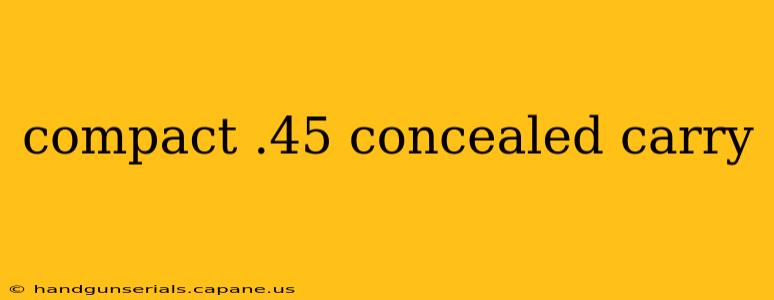Choosing a compact .45 ACP for concealed carry is a serious decision demanding careful consideration. The .45 caliber offers significant stopping power, but its size and recoil can present challenges for concealed carry. This guide explores the nuances of choosing the right compact .45, addressing factors like size, weight, features, and ammunition.
Understanding the .45 ACP for Concealed Carry
The .45 Automatic Colt Pistol (ACP) cartridge is renowned for its substantial stopping power, making it a popular choice for self-defense. However, its larger size and heavier recoil compared to smaller calibers like 9mm or .380 ACP mean that finding a truly compact and comfortably concealable .45 requires careful selection. The trade-off is always between manageable size and the powerful stopping power of the .45.
Key Factors to Consider When Choosing a Compact .45 for Concealed Carry
Several critical factors influence the selection of a compact .45 for concealed carry:
1. Size and Weight:
- Grip Size: A compact .45 should have a grip that fits your hand comfortably and allows for a secure, controlled grip, even under stress. Too small, and you risk discomfort and reduced control; too large, and concealment becomes difficult.
- Overall Dimensions: The gun's overall dimensions (length, height, and width) directly impact concealability. Look for models designed specifically for concealed carry with minimized overall size.
- Weight: A heavier gun will be more difficult to carry comfortably all day. While heavier guns can reduce felt recoil, excessive weight can be a significant drawback.
2. Capacity:
While a compact .45 will likely have a lower capacity than its full-size counterparts, you still want to maximize the number of rounds you can carry. Look for models with higher magazine capacity options. Extended magazines might compromise concealability, so find a balance that suits your needs and comfort level.
3. Features:
- Safety Mechanisms: Consider the type of safety mechanisms offered (e.g., grip safety, manual safety, trigger safety). Choose a safety mechanism that aligns with your comfort and training.
- Sights: Good sights are crucial for accurate shooting, particularly in a self-defense situation. Night sights are a worthwhile upgrade for low-light conditions.
- Reliability: Reliability is paramount in a self-defense firearm. Research the reputation of the chosen model for reliable function.
4. Ammunition Considerations:
Choosing the right ammunition is crucial for optimal performance. Consider factors such as bullet type (e.g., hollow point, full metal jacket), weight, and stopping power. Practice with your chosen ammunition to ensure reliability and accuracy.
Popular Compact .45 ACP Models (No specific models are named to avoid directing readers to commercial sites)
Several manufacturers produce compact .45 ACP handguns specifically designed for concealed carry. Researching models from reputable manufacturers will yield several options that meet varying needs and preferences. Remember to handle and test fire any handgun before purchasing to ensure a comfortable and secure fit.
Concealed Carry Best Practices
Regardless of the chosen firearm, responsible concealed carry necessitates rigorous training and adherence to all applicable laws and regulations. Obtain professional training from a qualified instructor to develop safe handling techniques, proper shooting skills, and legal knowledge related to concealed carry.
This guide provides a framework for choosing a compact .45 ACP for concealed carry. Remember to prioritize safety, training, and responsible gun ownership above all else. The decision to carry a concealed firearm is a significant one, and thorough research and preparation are essential.

